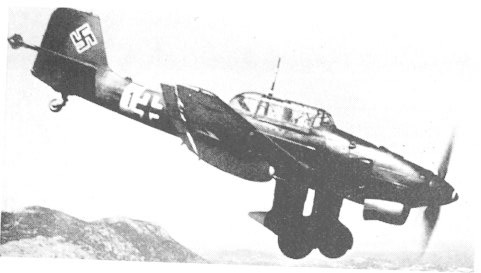|

|
Ju 87 deliveries to Luftwaffe squadrons began in the spring of 1937. Late that year Ju 87s began to arrive in Spain to support the Nationalist forces in the Spanish Civil War. Despite relatively poor performance, the Ju 87 was effective against both ground targets and shipping. The Ju 87 saw combat on every front on which the Germans fought during the war. Designed to serve as "long-range artillery" to support the German Army, the Ju 87's bombing accuracy was less than 30 yards. The plane was employed in the Battle of Britain beginning in July 1940, with some 280 Ju 87's available for strikes on Britain. But the Stuka was withdrawn on Aug. 19 following heavy losses from RAF fighters. Subsequently, the aircraft was flown extensively in the Mediterranean and on the Eastern Front, again with great success. Flying in the anti-shipping role, the Ju 87 was able to heavily damage two British aircraft carriers in the Mediterranean, and to sink and damage many other ships. Late in the European War the Allied control of the air over Germany forced the employment of the Ju 87 as a night bomber. By the end of 1935 the Junkers firm had produced the prototype Ju 87, which was flight tested late that same year. The single-engine plane had inverted gull-shaped wings, an in-line, water cooled engine, and large, fixed landing gear with "spats" covers. Bombs were carried under the wings and fuselage, and the cockpit held a pilot and radio operator, the latter firing a machine gun to protect the rear of the plane when in a dive. In production aircraft an autopilot was fitted to take control if the pilot blacked out during a dive. The plane was considered easy to fly and very popular with its pilots. The Ju 87C variant had upward-folding, outer wing panels, a tail hook, and other features for use from the never-finished aircraft carrier Graf Zeppelin. The Ju 87D-3 was experimentally fitted with twin pods on its wing, each for carrying two agents who were to be dropped behind enemy lines; despite extensive tests, this scheme was not adopted.
|